THE SPIDER’S WEB: Timing can be everything…

—
Welcome to The Spider’s Web — a recurring feature by novelist and Archie Comics Co-President Alex Segura that looks at Spider-Man’s development since his start in 1962’s Amazing Fantasy #15. (Alex has been re-reading from the beginning.) Each installment covers a specific period in Spidey’s history, with Alex giving you a kind of bouncing ball approach, as opposed to an issue-by-issue breakdown. Click here for the complete index of columns. — Dan
—
By ALEX SEGURA
Hey Spider-Pals, welcome back. Last time we chatted, I was closing out my look at the legendary, classic, insert-effusive-word-here Stern/Romita Jr. run on Amazing Spider-Man. Let’s just call it like it is — aside from Lee/Ditko/Romita and Gerry Conway’s runs, Stern/JRJR is the high-water mark up to this point. It doesn’t get better.
Tough act to follow, huh?
With an editorial change (from Tom DeFalco to Danny Fingeroth) and his artist moving over to focus on the X-Men, Roger Stern felt it was time to move on. He’s also noted that he might have reconsidered had he known Ron Frenz was stepping in as artist. These are all What If? scenarios, alas, so let’s deal with the realities: Following Stern was a thankless job – and what we got in DeFalco and Frenz was pretty good to great.
It was nearly impossible to capture the consistent excellence of the prior team, but DeFalco and Frenz made a valiant, honorable effort — crafting a run loaded with great moments. That said, the run’s momentum did hit some snags; not through any fault of the two creators, but due to what seems like elements out of their control.
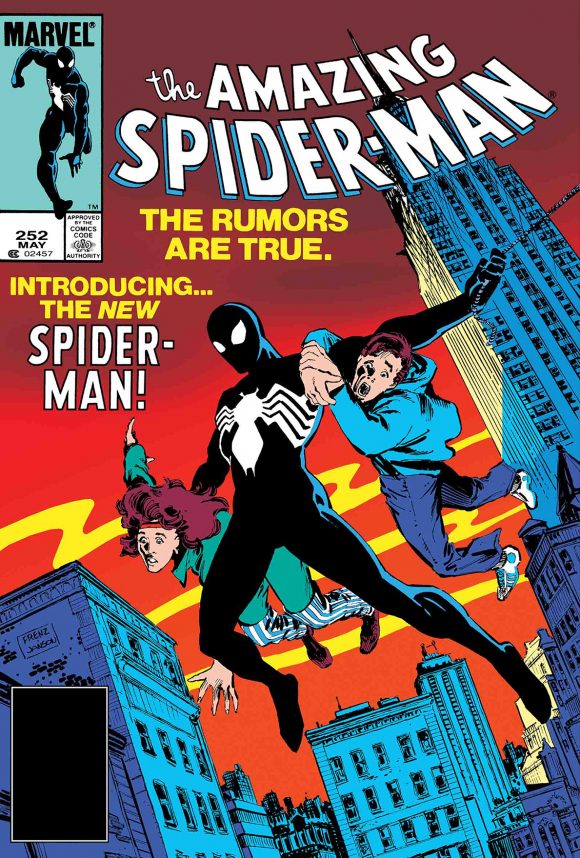
This era of Spider-Man not only features a lot more external story factors — it kicks off with Spidey debuting his new black costume, which becomes an ongoing plot thread — but also has to tangle with a handful of Secret Wars and Secret Wars II crossover elements, whether it’s the Beyonder turning a building into gold or the fallout from the first Marvel mega-crossover.
On top of that, DeFalco had the added challenge of now having to reference not only what happened in Peter Parker: The Spectacular Spider-Man, but also the newly-launched Web of Spider-Man, which replaced Marvel Team-Up. It’s a lot of juggling, which an editorial vet like DeFalco does well — but it does create a sense that there’s a LOT of Spidey stuff going on, and it’s not all happening in the flagship.
While we’ve had multiple Spidey titles for a good long while now, this felt like the first run where I, as a reader, felt the weight of the other books — where it seemed like, from my POV, some of the big stuff was happening elsewhere. We felt a bit of that at the end of Stern’s run, as Spidey dealt with the fallout of Black Cat’s injury in PPSSM, during Al Milgrom’s great Ock/Owl story.
A few examples of big stuff happening elsewhere? Spidey gets new duds — but the costume reveal happens a bunch of places before 1984’s Amazing Spider-Man #252, DeFalco’s second issue as writer (with Roger Stern). Later, Spidey goes toe-to-toe with the symbiote in the first arc of Web of Spider-Man, and Black Cat and Spider-Man end their long-running romance at the end of Milgrom’s PPSSM run.
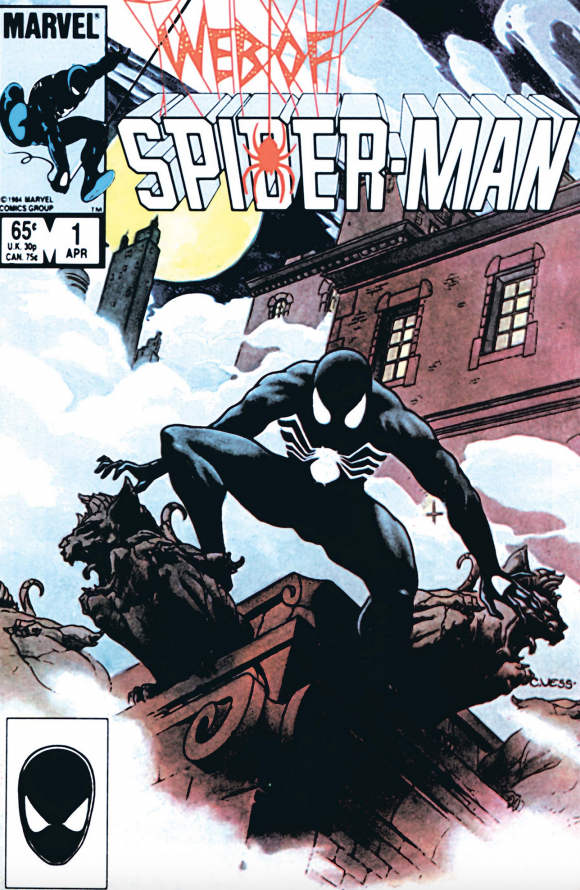
What’s my point? Well, it’s not a bad thing, per se — but it does present unique challenges, and it creates a situation where the flagship has to reference the satellites, while each series tries to establish a unique identity. In short, it’s an extra hurdle — for the writer and reader. For the bulk of this re-read, I’ve been using ASM as the nexus point for the character, with only slight detours based on quality or interest — but that changes a bit with this run, as I felt compelled to read other arcs just to make sure I was up to speed. More on that later.
DeFalco and Franz, to their credit, come out swinging — introducing a bunch of cool new characters that will have a lasting impact on the Spider-Mythos. Whether it’s mysterious crime boss the Rose, feral baddie the Puma, geriatric jewel thief the Black Fox, Harry Osborn’s kid Normie, mercenary leader Silver Sable, the required silly rogue introduction in Slyde, the Sinister Syndicate, or carrying on Stern’s affinity for the Jack O’Lantern, the vibe in the first dozen or so issues is one of energy, dynamism, and professional execution. These people know how to make comics. They feel bombastic and fun, with loads of love for the source material.
Frenz, particularly when inked by Joe Rubinstein, does a spot-on Ditko impression, and his art is really top-flight for the majority of the run. A fine draftsman and superb storyteller, he does what you want an artist to do — tell a story and tell it so well you forget what you’re even looking at is art. Not a step was missed when Frenz took over for JRJR, and he really should get more credit than he does for this and everything else on his illustrious resume.
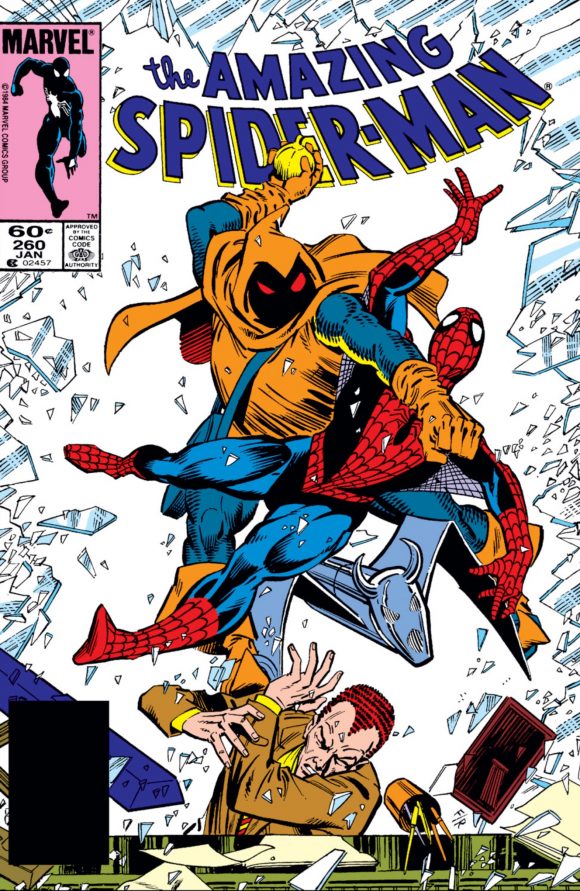
Many people focus on the Hobgoblin in regards to DeFalco’s run, specifically how he carried on the mystery set up by Stern — some people dig what he did, some don’t. But that’s the reality of serialized storytelling. Sometimes you don’t get to conclude every plot thread you initiate, even when you create a villain. In Stern’s case, he did get to resolve it. But we’ll touch on that later.
As it applies to DeFalco’s run, he made clear he didn’t really love Stern’s take on the big reveal, going his own way instead. Though, even DeFalco’s take would be ignored by the eventual “solution,” only to be retconned by Stern’s Hobgoblin Lives! series. (Again, more on that in a bit.) My point being — there’s a lot more to the DeFalco run than the Hobgoblin. In fact, I’d argue that one of his lasting contributions to the mythos was his focus on Mary Jane Watson.
Stern had already set the stage by bringing the classic character back to the series, but DeFalco took it to the next level — creating a slow boil “will they or won’t they?” dynamic that establishes the ex-lovers as friends first, but evolving slowly into something more. The turning point? The revelation that MJ knows Peter’s secret identity — and has for a long time. It’s a thoughtful and meaningful retcon, and it recalibrates the dynamic in a smart way — setting up their eventual marriage.
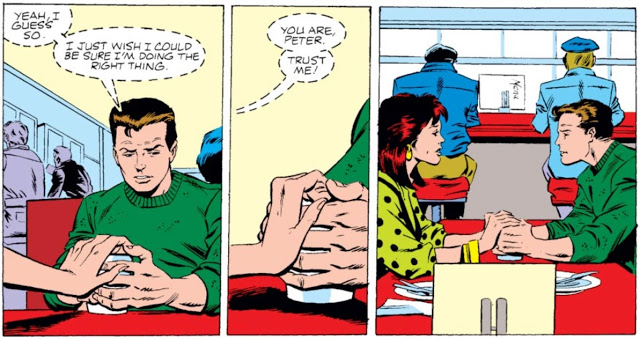
DeFalco also explores MJ’s family history, which gives some context to why she is who she is, adding depth to a character most fans had probably written off by this point.
***
As far as the Hobgoblin goes, DeFalco and Frenz do some interesting things — like Hobby’s framing of Flash Thompson (and tying it into the Ned Leeds/Betty Brant marital strife), and becoming an enforcer for the Rose. DeFalco also manages to carry over some of the strengths from Stern’s run — specifically Stern’s habit of having Spidey face off against non-Spidey foes. In DeFalco’s case, it’s the Red Ghost, Titania and the Absorbing Man, and, most notably, Firelord.
Now, I know a lot of people love the Firelord two-parter — who doesn’t like Spider-Man facing off against a supreme foe and bucking the odds? It is a fine story. But for me it happened too soon after the Juggernaut two-parter to feel wholly new. That could just be a byproduct of reading these issues at a good clip (and the scene where Firelord melts a pizza oven is worth the price of admission alone).
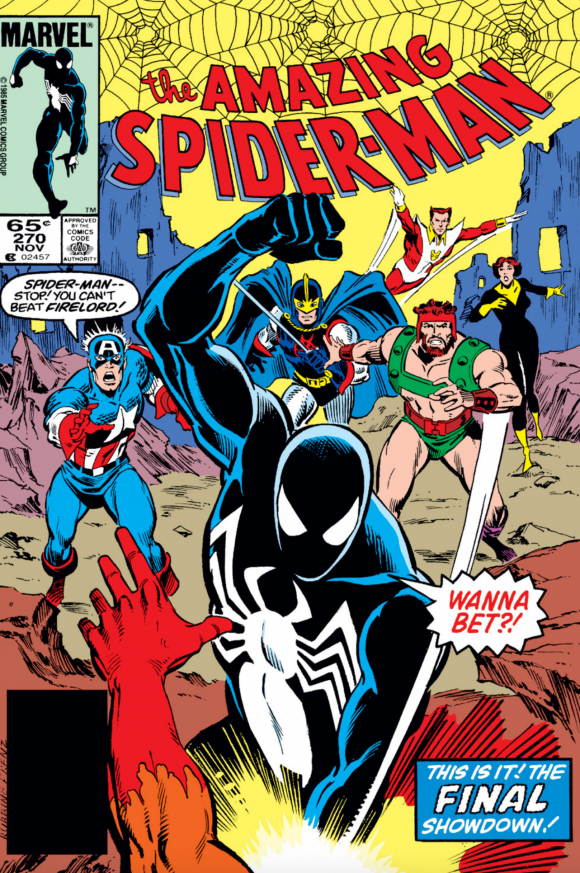
Still, it feels like a riff on the earlier, more beloved tale — and the subsequent one-shot spotlighting original Spidey adversary Crusher Hogan also evokes another, earlier Stern classic, The Kid Who Collects Spider-Man.
I’m not saying DeFalco tried to follow in Stern’s footsteps. It’s hard to add new tricks to a series that’s run for close to 300 issues. If anything, it shows that DeFalco and Frenz knew what worked, and they did those things very well. It’s a testament to them as savvy veteran talents that they not only added to the Spider-Man lore, but also expanded on it and amplified the things that seemed to resonate. It’s a hard thing to quantify, but it’s clearly evident here.
***
I noted earlier that this run had its share of fill-ins — mostly written by then-newcomer Peter David — and most are entertaining and fun, though not completely essential to the main plot. Still, The Commuter Cometh, by David and artist Bob McLeod, is a particularly good time.
Now, the one big tragedy of the DeFalco/Frenz run is how it ends — with a whimper more than a bang. After attaining such great heights and really establishing a consistent vision and rhythm, as a reader, it feels like the rug is pulled out from under you. After a fun Sinister Syndicate two-parter and an early appearance from X-Factor, DeFalco and Frenz close things out with the aforementioned Absorbing Man and Titania brawl, and then… nothing?
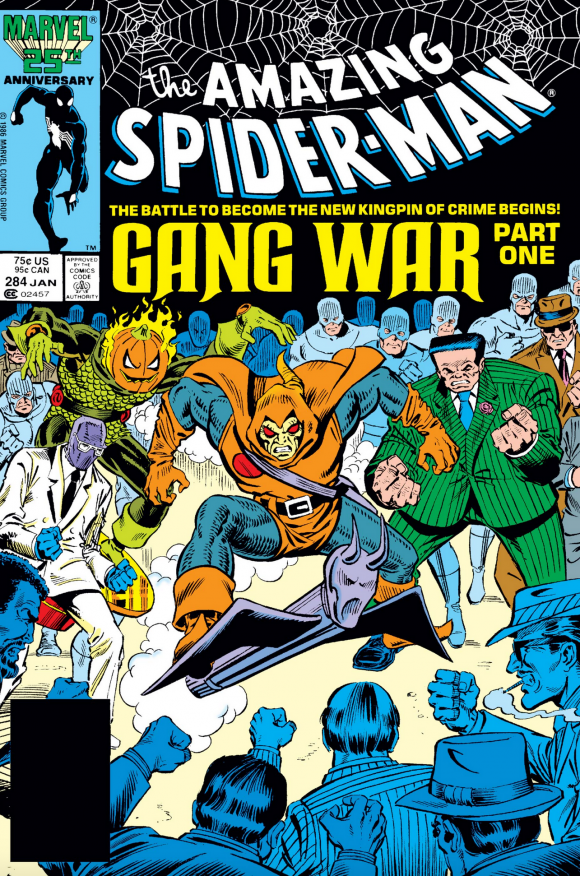
The series falls into a complicated Gang War storyline that finds the gangs of New York battling for supremacy in the wake of the Kingpin’s demise (as seen in the pages of Daredevil: Born Again). I’ll talk about that story next time, but suffice to say — it would’ve been nice to see DeFalco and Frenz close things out on their own terms.
What happened?
This piece by Priest, formerly Jim Owlsey, editor of the Spidey books during the bulk of DeFalco’s run, is worth a read — though it has been disputed to varying degrees. I linked to it last time, but it feels more relevant now. It sheds some light on the challenges he faced running the Spider-Man group. It paints a complicated picture, and it also explains some of the bumpy story beats readers experience toward the end of the 200s of Amazing Spider-Man.
Overall, the DeFalco/Frenz run is a hidden gem in terms of Spidey lore, often overshadowed by the more acclaimed Stern/JRJR issues, but deserving of more attention and love. It’s clear these guys have a passion for Spider-Man, and both would return — DeFalco would have a lengthy run on Spectacular Spider-Man during the Clone Saga and the duo would reunite for the myriad Spider-Girl series that garnered huge support in the early part of the century.
If you haven’t read their original ASM run, check it out. Lots of great stuff there.
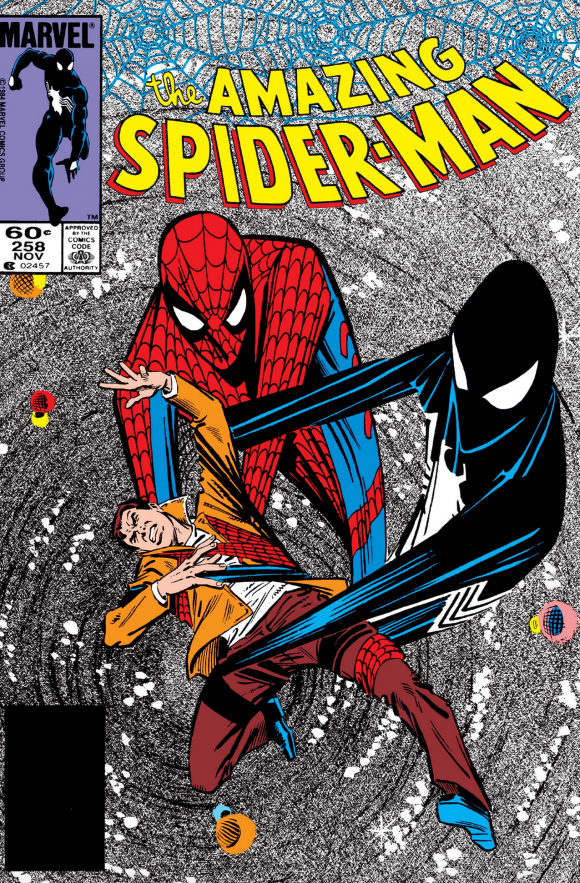
—
A few things before I go:
— There is a pretty bonkers Matt Murdock/DD cameo in Amazing Spider-Man #277, which is happening concurrently with Frank Miller and David Mazzucchelli’s seminal Born Again. It’s definitely a sign of what’s to come, in terms of companies trying to tie everything together to get you to buy more books. But it doesn’t derail the reading experience too much.
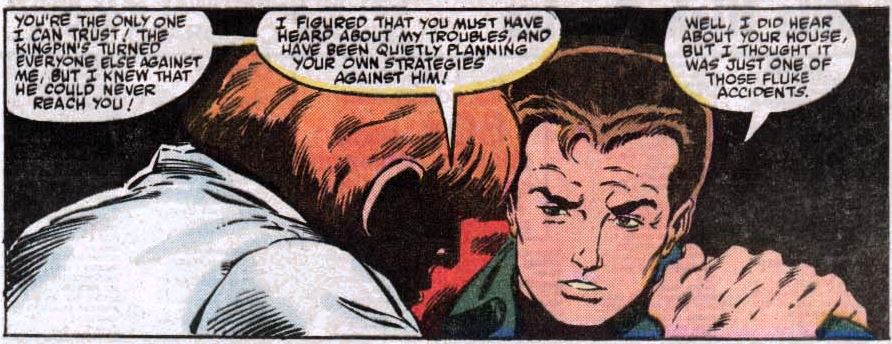
— Rick Leonardi, one of the most underrated artists in comics, does some solid and memorable fill-ins for Frenz during the DeFalco run. Also, Spidey vet Sal Buscema pairs with the legendary Kyle Baker for an unforgettable issue introducing the forgettable villain, Slyde. The pairing doesn’t seem like it’d make sense, but the end result is unlike anything I’d ever seen. Dig it up.
— OK, so after finishing the Stern run, I made myself jump forward and read Stern’s Hobgoblin Lives! mini, a three-issue story that resolved, once and for all, the Hobgoblin’s identity and gave Stern the opportunity (unusual, in comics) to finish a story his way. The mini-series features art by Frenz and an all-star crew of inkers, including George Perez and Jerome K. Moore. The end result is entertaining enough, and definitely works when read immediately after the initial run.
Stern manages to tie up even the most minute threads capably, and you wonder why it’d been so long (about a decade) since he’d written the web-slinger. Is it essential? I dunno. At this point, fandom had seemingly come to terms with the idea that Ned Leeds was the Hobgoblin. But Stern’s execution is so meticulous you can’t help but be wowed by the thought that goes into it. Frenz’s art is also first-rate. A fun, classic-feeling Spidey story that, IIRC, was a balm during a particularly challenging era for the hero.
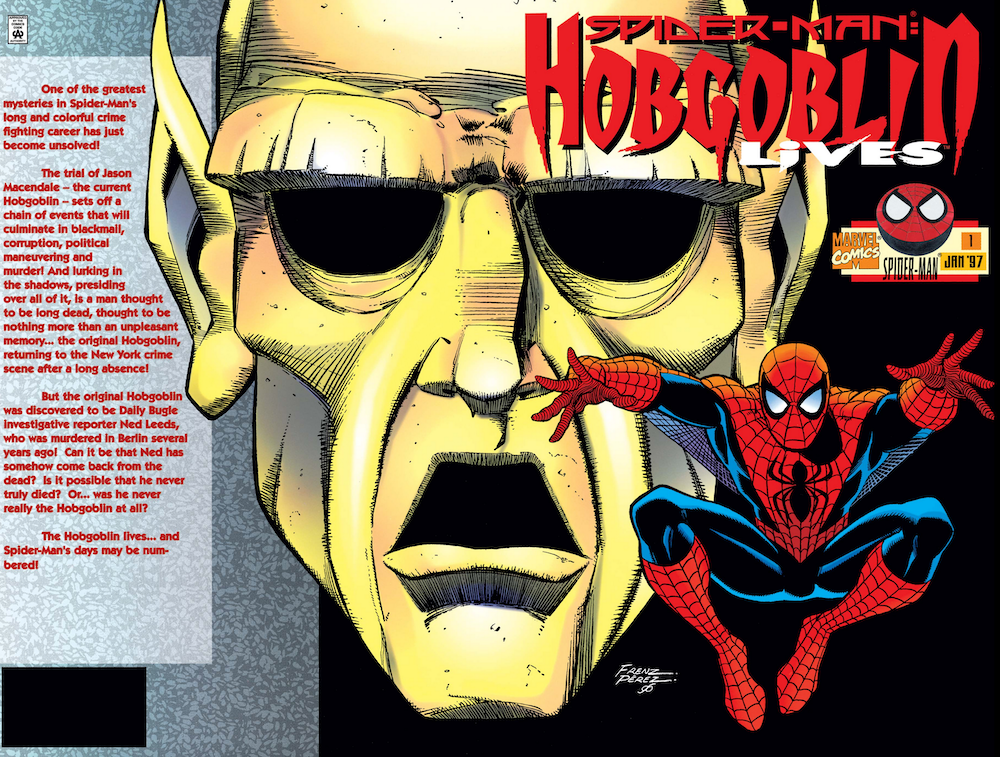
— As I noted earlier, this era of Spidey was interesting because big things were happening elsewhere in the Spider-Man line of titles. One of the stories that fits that bill is The Death of Jean DeWolff, by Peter David and artist Rich Buckler. It’s considered a classic ’80s Spider-Man story, and very much fits the era’s “grim and gritty” mold. I hadn’t read it in ages, but it’s referenced briefly in DeFalco’s run, so I felt compelled to revisit it.
As I remember it, DeWolff was mainly a supporting cast member in Marvel Team-Up, though she did pop up sparingly in Stern’s runs on Amazing and Spectacular. She, like D.A. Tower, appeared fairly consistently for some time. I have very vague memories of my original reading of the four-issue story — so I wasn’t expecting it to be so grimdark. The opening page plays for shock and the rest of the story serves as an interesting mystery, exploring the identity of the “Sin-Eater,” who felt the need to murder DeWolff.
The story is compelling enough, but I’m not really sure it’s aged all that well. Definitely one of the darker Spider-Man stories, and one that signals the peak of Spidey’s grimmer, black costume era.

— NEXT TIME: We transition from DeFalco to David Michelinie — but most importantly, we deal with one of the best Spider-Man stories ever — J.M. DeMatteis and Mike Zeck’s legendary Kraven’s Last Hunt!
—
MORE
— For the Complete THE SPIDER’S WEB Index of Features. Click here.
— ENTER THE HOBGOBLIN: Stern and Romita Jr.’s Superb Achievement. Click here.

November 6, 2020
I’m entranced by the covers with Spider-Man’s black costume.
November 6, 2020
Agree with Philip above – that black costume really is sleak and beautiful.
I don’t have a lot of the DeFalco/Frenz run, but what I have and/or have read, I really enjoyed. There are some tremendous stuff in that Firelord story (like Spidey luring FL into coming head-on into a subway, but then him heating himself so he melts the front and passes right through it – then Spidey kicking himself because he could have killed everyone on the train).
As mentioned, great and fun story and art. Great article.
November 6, 2020
At the time, I seamlessly enjoyed the DeFalco/Frenz run, after loving the Stern/JRJR run. Loved the revelation about the black costume in ASM #258, and of course, the coming of Bag Man! I mean, that costume has had a life of it’s own too, and that’s DeFalco/Frenz. One amazing thing about this team is the recreated the feel of the Lee/Ditko days very well here, then went over to Thor and turned back the clock to Lee/Kirby!
I read an article on the Hobgoblin debacle in Back Issue many years ago, and I recall reading about the events leaving a pretty nasty taste in my mouth. Lots of behind-the-scenes back-biting made for a really lousy wrap-up for a great storyline. The puppet strings were really showing.
October 12, 2021
“The death of Jean DeWolff” the great story tremendously current. Only drawback: discovery of Sin-Eater’s identity in the apartment.